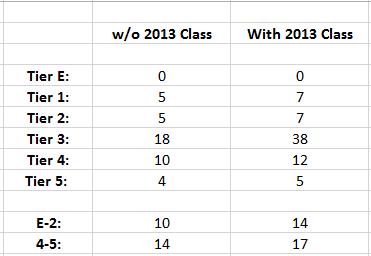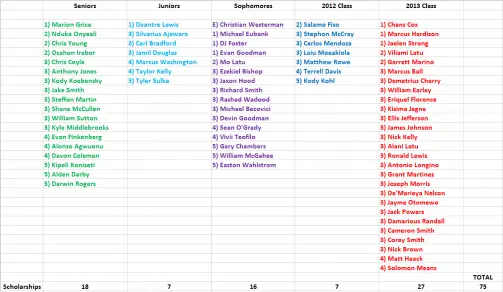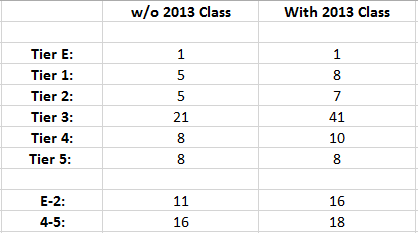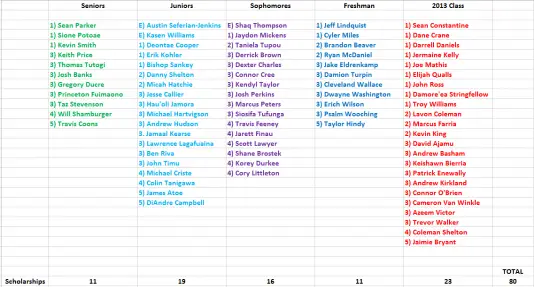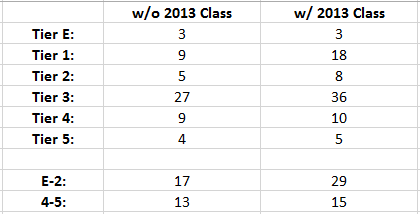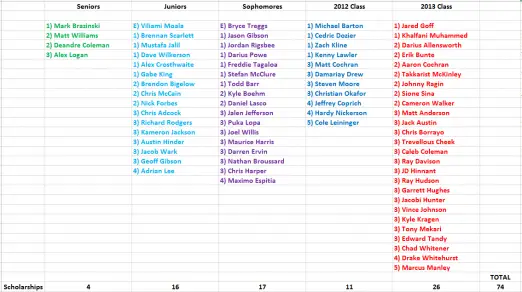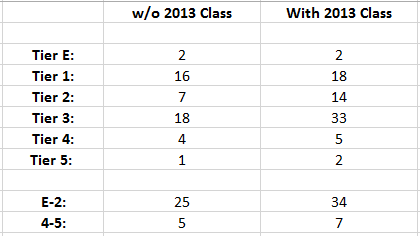Last week, we looked at #12 through #9 of the Pac-12 Talent Rankings. This week, we profile four more squads. Below is an explanation of our tier-system used to compile the data:
- Tier-E: 5-star rating by at least one service
- Tier-1: 4-star rating by at least two services
- Tier-2: 4-star rating by one service
- Tier-3: 3-star rating by at least two services
- Tier-4: 3-star rating by one service
- Tier-5: No 3-star rating by any service
Before we get started, I wanted to address a couple of things as a result of responses to last week’s rankings:
– These rankings ARE NOT subjective. I don’t rank teams based on personal observations and opinions. That’s part of what makes them unique. They are compiled using the best objective data available: recruiting rankings (four sets of them for each player).
– It is possible that the #10 team in these rankings is better than the #3 team in a given year. How? Well, chemistry, leadership, talent development and good coaching in general. The coaching component would include offensive/defensive system, game planning, play calling and roster management. All these traits play significant roles in the formulation of a good TEAM. All the individual talent in the world can’t make up for a program that lacks leadership, chemistry and a coaching staff that has the respect of the players or implements an effective game plan. That said, as described in the introduction to this series, study after study has shown the strong positive correlation between talent (based on recruiting rankings) and winning.
– “E-2″ represents the total combined Tier-E, Tier-1 and Tier-2 players. ”4-5” represents the total combined Tier-4 and Tier-5 players.
Now, let’s get down to business…
#8 – Utah Utes
What I Said Last Year
“Utah’s move to the Pac-12 proved to be a good one on the recruiting trail. Their E-2 talent doubled, which is a great sign moving forward.”
“If the Utes can put together another couple of classes like the one they just assembled, they’ll be able to compete at a relatively high level and separate themselves from the bottom half of the conference.”
“Utah isn’t exactly a hotbed of talent, so that alone limits the team’s potential.”
2012 Season Recap
Last season, Utah got a harsh dose of reality and learned, definitively, that the Pac-12 is not the Mountain West. After a disappointing loss to Utah State, the Utes went on to finish 5-7 (3-6 in conference) including four straight losses to ASU, USC, UCLA and OSU. That was obviously a brutal four-game stretch; one that was never matched back in their Mountain West days.
Talent Summary
The argument could be made that Utah should be #7 in these rankings. The majority of the roster is made up of tier-3 players, with almost as many E-2 players as 4-5 players. This gives them a slight advantage over the teams below them in the standings, but not enough advantage to be definite favorites when matched up against them. On the bright side, they’ll be able to take a huge class in 2014.
What the Future Holds
The transition to a major BCS conference might take longer than Utes fans initially thought. Finishing in the bottom half of the conference in consecutive years is tough for a program. Especially one that had established itself as the alpha dog of the Mountain West before leaving for greener pastures after the 2010 season. Some are surely regretting that decision. Given their location and the teams they’re competing against for elite recruits, it’s hard to imagine Utah being a contender in the Pac-12. It’s possible that they could have a good year every now and then, but long-term the Utes look like a team that’s going to struggle to stay out of the bottom third of the standings. Along with the Cougars, Buffaloes and Beavers, there doesn’t appear to be much room for Utah to improve its talent profile. The fact that the Wildcats and Sun Devils are both programs on the rise doesn’t help matters. In 2013 look for Utah to have another disappointing season, and expect that to become the norm. Making it to a bowl game should be the goal.
#7 – Arizona State Sun Devils
What I Said Last Year
“There’s definitely some talent on the roster, but there’s a lot of fat too. Todd Graham has some work to do on the recruiting trail if he wants to compete at a high level in the Pac-12.”
“The direction this team heads is anybody’s best guess.”
“This isn’t a team that’s talented enough to compete with the Trojans or the Ducks, and the only realistic way that changes, outside of bringing in a system coach, is to improve recruiting over the next few years.”
2012 Season Recap
The Sun Devils finished about as expected last year, missing a couple of opportunities that could’ve contributed to a great season. A close, early season loss to Missouri kept ASU from starting 6-0. Ultimately, they finished 8-5 (5-4 in conference) with four straight losses coming against Oregon, UCLA, Oregon State and USC. The Sun Devils recovered, though, winning their last three games including a 62-28 beatdown of Navy in the Kraft Fight Hunger Bowl.
Talent Summary
The Sun Devils are in the same spot as the Utes, except with more potential to improve their situation. While they’ve got plenty of tier-3 players, Arizona State needs to add more E-2 talent to break through and compete with the top conference teams. They’ll have their chance with the ability to take a big class in 2014.
What the Future Holds
The Sun Devils are certainly a team on the rise, but their ceiling is approaching. The state of Arizona has enough talent to carry one college football team, but not two. Unfortunately for the Sun Devils, UA is improving just as rapidly as they are. Long-term, it will take one of the Arizona teams really falling off to give the other a chance to put a fence around the state and lock down all the top in-state talent. Even then, there are plenty of highly ranked players who choose to leave the state every year. While they do recruit across state lines, realistically the Sun Devils are going to have a hard time competing with USC, UCLA, Cal, Stanford, Oregon or even Washington for California’s best. ASU and UA can certainly co-exist as low-level bowl teams, and that’s what I think the foreseeable future holds. That said, 2013 could be a special year for the program. The South division doesn’t have a dominant team and Arizona State’s best unit, its defensive line, will give them a chance to win every game. It wouldn’t be surprising to see them win the South.
#6 – Washington Huskies
What I Said Last Year
“A couple of top-15 classes would go a long way towards solidifying the Huskies as a true conference contender.”
“The additions of Justin Wilcox and Tosh Lupoi will make a serious difference on the recruiting front. Those two could help change the fortunes of the program from one wallowing in mediocrity to one with BCS aspirations.”
“This is a team on the rise. I expect the Dawgs to land a couple good recruiting classes in a row and become real conference players.”
“I’m still not convinced they can become a consistent BCS contender, but it’s not out of the realm of possibility.”
2012 Season Recap
It was an up and down season for the Huskies, who finished 7-6 (5-4 in conference). They were blown out by LSU, Oregon and Arizona (by a combined score of 150-50) but had a nice win against Stanford, who eventually won the Rose Bowl and finished the year ranked #3 in the AP poll. The season would have been better had Washington been able to win their last two games, which they lost in brutal fashion: 28-31 @ WSU and 26-28 vs. Boise State in the MACCO Las Vegas Bowl.
Talent Rankings
Now with almost twice as many E-2 players as 4-5 players, Washington is the first team to really separate themselves from the Pac(k). They are significantly more talented than Arizona State. 29 E-2 players make up more than a third of their scholarship players, meaning the Huskies have the potential to play at a high level. Expect a moderately-sized 2014 class unless the program experiences a lot of attrition.
What the Future Holds
I’m not sure why Husky fans are so quick to defend Steve Sarkisian. Maybe it’s because of all that charm that helped him land the job in the first place. Maybe it’s because of his success at USC. And maybe (aka probably) it’s because he’s not Tyrone Willingham. All I know is that he’s not getting the job done. The Huskies were far too talented last year to finish 7-6 and lose to Washington State in the Apple Cup. While the team continues to add talent, the coach who has led them to one disappointing season after another, remains. I’m not buying the whole “this is the year we break through” company-line anymore. Show me. I have a feeling that Washington’s athletic director and boosters are saying the same thing. With a bunch of talent and a new stadium, there are big expectations; probably too big if history is any indication. I think “Sark” is in a position similar to the one Jeff Tedford was in last summer: if he doesn’t at least contend for a conference title in the next two seasons, he’s gone. Long-term, Washington’s future is bright. It’s a great university in a great city and they shouldn’t have much trouble recruiting well, especially once they start winning. There’s plenty of competition in the top half of the conference, but Washington will eventually return to relevancy, at least for a couple of years at a time. As for 2013, I expect an eight-win disappointment and an increasingly frustrated fan-base.
#5 – California Golden Bears
What I Said Last Year
“I can’t help but wonder what the [2012] class would look like had Tosh Lupoi not bolted to Washington. That whole situation was just brutal. Sorry to remind you. It was just so devastating.”
“This is a team that has the talent to compete on a high level.”
“Unless they can start producing on the field, Tedford isn’t likely to keep his job and the team isn’t likely to move up in these rankings.”
“I think Tedford is gone within two years… a new coach could give the program a real boost, but until then I don’t have high expectations.”
2012 Season Recap
The season was a disaster from the start, with a shocking loss in the opener against Nevada. It ended just as badly, with humiliating losses to Oregon and Oregon State, where the Bears were outscored 121-31. As I predicted last summer, head coach Jeff Tedford was justifiably let go; for a team as talented as Cal was to go 3-9 means the coach lost the players (see: losing their final two games by a combined 90 points).
Talent Summary
Nearly half of California’s roster is made up of E-2 players (34). Combined with 33 Tier-3 guys, Cal has the potential to hang with the Pac-12’s best. There isn’t much separating the Golden Bears from second place in these rankings, a reasonably attainable ceiling. That said, with only four scholarship seniors on the roster (an incredibly low number), Cal won’t be able to make up much ground with their next recruiting class.
What the Future Holds
The sky is the limit for the Golden Bears under Sonny Dykes. While having disappointing seasons as of late, everything is in place for Cal to become consistently relevant. Great university? Check. Great location in a talent-rich region? Check. New head coach who runs an exciting offense? You get the point; I think Cal is primed to make a serious run. It might be a couple of years until that prediction comes to fruition, but it doesn’t take a rocket scientist to see the potential at Cal. The only thing holding them back is a general lack of support from the University and boosters. Thus, it’s possible that they’ll be left behind in the facilities arms race, which would certainly hurt recruiting. Remember, it was just a year and a half ago that Cal was looking at landing one of the top classes in the country before Tosh Lupoi left for Washington and everything fell apart. With the right coaching staff in place California could absolutely join the conference elites. In 2013 anything could happen. It’s hard to know how quickly the new staff will be able to implement their system. There’s plenty of talent, especially along the defensive front-seven, so that should make the transition easier. Cal won’t be a contender right away, but it’s almost impossible for them to be any worse than they were last year.
Featured Image at top of article: Kevin Cline
—————————————————————————————————————————–
ANNOUNCEMENTS
*If you would like to join the other 80+ volunteers at FishDuck.com, and have five hours a week to donate… we have slots open for volunteer Editors, Writers, Analysts, Photo Archivists and Social Media Associates. Can you help us manage people? Consider our volunteer Sales Manager and HR Manager positions and give some time each week to help young associates learn! E-mail us at charles@fishduck.
*Don’t miss our football analysis every Tuesday, our Recruiting Update every Wednesday and our new Chip Kelly updates every Friday!
Related Articles:
Chip Kelly Update: Everything's Good Again ...
Chip Kelly Update: Wailing and Gnashing of Teeth
Shock and Awe -- The Oregon Ducks' Football Hangover Effect
Despite Lopsided Score, Georgia State "Never Stopped Believing"
Hope Springs Eternal for Ducks
Incompetent Pac-12 Officials: How Do You Miss ALL of THIS?
Chris was born in Montevideo, Uruguay, but made his way to Oregon by the age of five, when he attended his first game at Autzen Stadium. A huge sports fan at a young age, Chris grew up playing football, basketball and golf. Although realizing he isn’t likely to play in the NFL or NBA, Chris still holds on to hopes of being a professional golfer should his unfortunate putting woes take a turn for the better. A bit of a platypus, he attended both Oregon State and Oregon during his collegiate days where he earned a business degree in Finance and Business Administration. Chris works for Daimler Trucks North America in Portland, and plans to get his MBA from the University of Oregon.
Chris has been an active member in the recruiting community since 2005. He studies the intricacies of recruiting and is particularly intrigued by talent evaluation techniques. He is currently working on developing his own scouting reports for every scholarship player on the UO roster. Chris lives with his wife, Katrina, and his two-year-old son Lucas (a future dual-threat QB).


